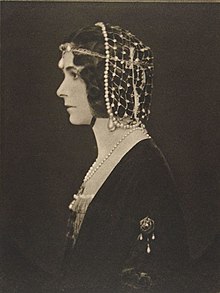Algernon Skeffington, 12th Viscount Massereene
Algernon William John Clotworthy Skeffington, 12th Viscount Massereene and 5th Viscount Ferrard, DSO (28 November 1873 – 20 July 1956) was British Army officer and an Ulster Unionist member of the Senate of Northern Ireland from 1921–1929. During this period he served as Deputy Leader of the Senate and Parliamentary Secretary in the Department of the Prime Minister.[1][2]
Early life
Skeffington was the eldest son of Clotworthy John Skeffington, 11th Viscount Massereene by Florence Whyte-Melville, only daughter of Major George Whyte-Melville. He succeeded his father as 12th Viscount Massereene and 5th Viscount Ferrard in 1905, both in the Peerage of Ireland; his inheritance included about 16,000 acres.[3] They also held the title Baron Oriel, in the Peerage of the United Kingdom, which gave them the right to sit in the House of Lords[4]
Career
He entered the army in February 1895, when he was commissioned a second lieutenant in the 17th Lancers, and was promoted to lieutenant on 13 November 1895. The regiment was stationed in Ireland from 1897 until 1900. Promotion to captain followed on 8 February 1900.[4] From 1900 to 1902 he served with his regiment in South Africa during the Second Boer War, where he was wounded, twice mentioned in despatches (including the final despatch by Lord Kitchener dated 23 June 1902[5]), and for which he was promoted a brevet major on 22 August 1902,[6] and created a Companion of the Distinguished Service Order (DSO).[7] He stayed in South Africa throughout the war, which ended June 1902 with the Peace of Vereeniging. Four months later he left Cape Town with other officers and men of the 17th Lancers on the SS German in late September 1902, and arrived at Southampton in late October, when they were posted to Edinburgh.[8] He retired from the army in 1907, but served again as an officer with the North Irish Horse in World War I 1914–18.
Lord Massereene was Parliamentary Secretary in the Department of the Prime Minister of Northern Ireland 1921–1929.[4]
He also served as Lord Lieutenant and Custos Rotulorum of County Antrim 1916–1938.[4]
Personal life

Lord Massereene married twice. In 1905 he married Jean Barbara Ainsworth (d 1937), eldest daughter of Sir John Ainsworth, 1st Baronet. They had one son:
- John Whyte-Melville-Skeffington, who succeeded as 13th Viscount.
In 1940 he re-married Mrs Florence Clementina Vere Vere-Laurie.[4]
References
- The Government of Northern Ireland
- Ark Elections, The Northern Ireland Senate, 1921–72
- "MASSEREENE, 12th Viscount". Who's Who. Vol. 59. 1907. p. 1189.
- MASSEREENE and FERRARD’, Who Was Who, A & C Black, an imprint of Bloomsbury Publishing plc, 1920–2008; online edn, Oxford University Press, Dec 2007
- "No. 27459". The London Gazette. 29 July 1902. pp. 4835–4839.
- "No. 27490". The London Gazette. 31 October 1902. p. 6898.
- "No. 27359". The London Gazette. 27 September 1901. p. 6305.
- "The Army in South Africa - Troops returning Home". The Times (36888). London. 2 October 1902. p. 4.
External links
- . . Dublin: Alexander Thom and Son Ltd. 1923. p. – via Wikisource.
| Political offices | ||
|---|---|---|
| New parliament | Deputy Leader of the Senate of Northern Ireland 1921–1929 |
Succeeded by 6th Viscount Bangor |
| New office | Parliamentary Secretary Department of the Prime Minister (Northern Ireland) 1921–1929 |
Succeeded by 6th Viscount Bangor |
| Peerage of Ireland | ||
| Preceded by Clotworthy John Skeffington |
Viscount Massereene and Viscount Ferrard 1905–1956 |
Succeeded by John Whyte-Melville-Skeffington |